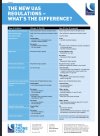In theory it could be the drone would adjust pretty much instantly. And you're really not getting huge sudden wind shear at the altitudes and envelope a drone is flown in.
Basic fact remains the drone will maintain an actual speed over ground unless the wind strength overcomes its ability to adjust pitch further to do so.
Basic fact remains the drone will maintain an actual speed over ground unless the wind strength overcomes its ability to adjust pitch further to do so.












